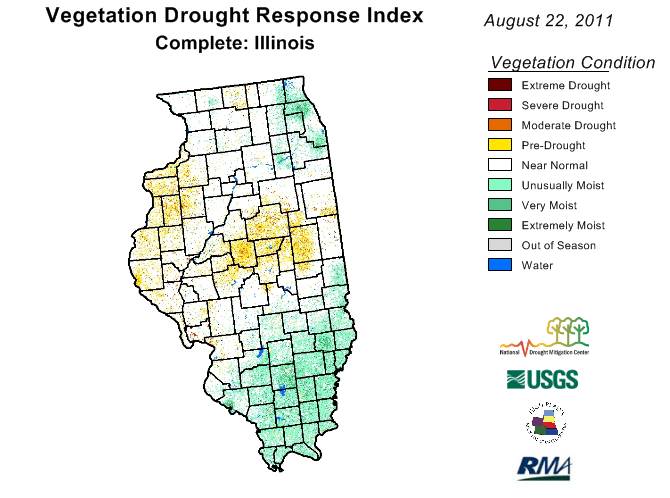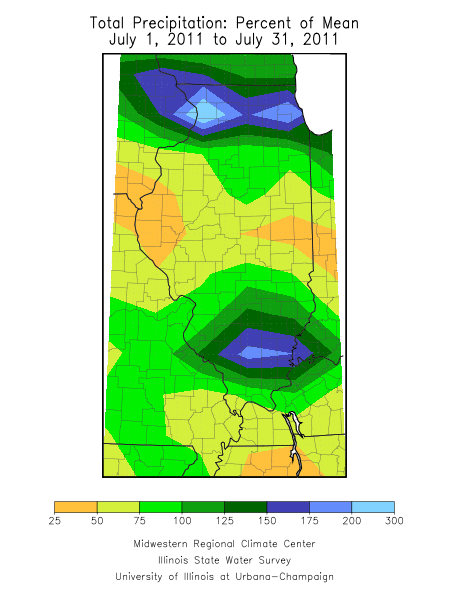There is a new way to look at drought stress in Illinois – from space. Called VegDRI, this product integrates “satellite-based observations of vegetation conditions, climate data, and other biophysical information such as land cover/land use type, soil characteristics, and ecological setting. The VegDRI maps that are produced deliver continuous geographic coverage over large areas, and have inherently finer spatial detail (1-km resolution) than other commonly available drought indicators such as the U.S. Drought Monitor,” according to the VegDRI website.
In other words, it looks at crop stress as it relates exclusively to drought. The maps are updated every two weeks.
The August 22, 2011, map below shows that crops in much of western and central Illinois are showing much stress from the lack of rain and high temperatures in July and August. If you go to the VegDRI website, you can see a national map. Click on a state to get a closer view. Scroll down the state page and click on the quadrant map of the state so see even more detail.


The National Drought Mitigation Center produces VegDRI in collaboration with the US Geological Survey’s (USGS) Center for Earth Resources Observation and Science (EROS), and the High Plains Regional Climate Center (HPRCC), with sponsorship from the US Department of Agriculture’s (USDA) Risk Management Agency (RMA). Main researchers working on VegDRI are Dr. Brian Wardlow and Dr. Tsegaye Tadesse at the NDMC, and Jesslyn Brown with the USGS, and Dr. Yingxin Gu with ASRC Research and Technology Solutions, contractor for the USGS at EROS.
Extreme Dryness in August for Much of Illinois
While the rains continue in northeastern Illinois, much of the rest of the state has been bone dry in August. Rainfall totals range from 3-5 inches in the Chicago area to less than an inch in many locations across central and southern Illinois. This band of dryness extends from southern Minnesota, eastern Iowa, Illinois, and into parts of Indiana and Kentucky (see first map).
Rainfall departures are on the order of 1-2 inches below average in the driest areas. Some of those same areas received little rainfall in July. The US Drought Monitor has much of central and southern Illinois in at least “moderately dry” with “moderate drought” in the central region of the state.
Of particular concern to me is that the few opportunities for substantial rain in August across central Illinois have resulted in only scattered showers/thunderstorms at best. There is another chance of rain on Tuesday/Wednesday but the projected amounts are on the order of 0.25 inches or less.
Update: USDA, National Ag Statistics Service (NASS) released the following on Illinois topsoil moisture (percent) by crop reporting district:
| District | Very Short | Short |
|---|---|---|
| Northwest | 4 | 21 |
| Northeast | – | 18 |
| West | 49 | 44 |
| Central | 31 | 38 |
| East | 40 | 44 |
| West Southwest | 26 | 58 |
| East Southeast | 13 | 46 |
| Southwest | 20 | 40 |
| Southeast | 30 | 56 |
| State | 25 | 41 |


Drought Arrives in Central Illinois
The U.S. Drought Monitor had introduced D1 “moderate drought” into central Illinois. This is based primarily on very low rainfall totals of less than an inch in the last 30 days in this region, combined with temperatures that were 4 to 5 degrees above normal. The Illinois Ag Statistics Service note that the topsoil moisture was “very short” in:
- the West Crop Reporting District (CRD) at 38%
- the Central (CRD) at 14%
- the East (CRD) at 51%


July Rainfall in Illinois Varied from Too Dry to Too Wet
The statewide average rainfall for July in Illinois was 4.12 inches, only 0.29 inches above average. However, rainfall across the state varied widely from too dry to too wet.
Rainfall amounts in the northern third of the state were impressive with widespread areas in excess of 6 to 8 inches. The heaviest rains fell around Galena. A CocoRaHS observer (IL-JD-2) reported a monthly rainfall total of 19.21 inches while the nearby Galena NWS Coop observer reported 17.78 inches. In nearby towns:
- Elizabeth reported 16.74 inches (NWS),
- Freeport reported 12.08 inches (CoCoRaHS), and
- Mt. Carroll reported 11.33 inches (NWS).
The middle third of Illinois was exceptionally dry. Some of the smaller rainfall totals for July were just south and west of the heavy rainfall in northwest Illinois. One of the drier sites was Aledo with only 0.55 inches. Amounts of only 1 to 2 inches were common in central Illinois. This equates to rainfall departures that were generally 50-75 percent of average (or worse) across the region. Champaign-Urbana experienced its 20th driest July on record with only 1.58 inches, 3.12 inches below average. Springfield reported 1.09 inches and Peoria reported 1.66 inches.
The southern third of Illinois was wet, where amounts of 4 to 8 inches or more were common. The largest July rainfall total was at the NWS Du Quoin site with 8.88 inches.



